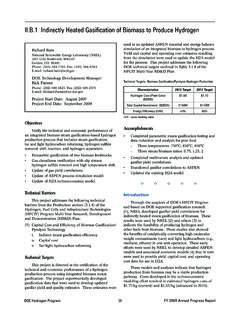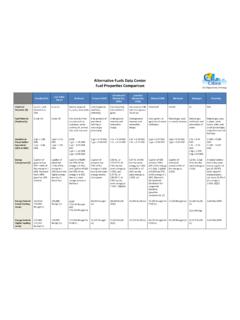Transcription of DOE Hydrogen and Fuel Cells Program Record 20004: Cost of ...
1 DOE Hydrogen and fuel Cells Program Record Record #: 20004 Date: September 14, 2020. Title: Cost of Electrolytic Hydrogen Production with Existing Technology Originator: James Vickers, David Peterson, Katie Randolph Peer Reviewed by: Levi Irwin, Daniel DeSantis1, Monjid Hamdan2. Approved by: Ned Stetson, Date: September 22, 2020. Eric Miller, and Sunita Satyapal Item Hydrogen can be produced from polymer electrolyte membrane (PEM) electrolyzers at a cost of ~$5 to $6/kg-H2, assuming existing technology, low volume electrolyzer capital costs as high as $1,500/kW, and grid electricity prices of $ to $ Table 1 shows the cost of Hydrogen can range from ~$4 to $6/kg-H2 with electrolyzer capital cost of $1,000/kW as an example and coupled to utility scale photovoltaic (PV) solar and utility scale onshore Table 1 Hydrogen costs for PEM electrolysis from H2A with associated inputs of electricity cost, capacity factor, and uninstalled system capital Electricity Cost Capacity Factor System CapEx H2 Cost ( /kWh) ($/kW) ($/kg).
2 1,500 $ Grid Low 1,000 $ 1,500 $ Grid High 1,000 $ NREL ATB 2020 [1]. Solar PV Utility 1,000 $ Los Angeles, CA. Solar PV Utility 1,000 $ Daggett, CA. Wind Onshore 1,000 $ Utility, Class 6. Wind Onshore 1,000 $ Utility, Class 1. 1. Project Engineer, Strategic Analysis, Inc. 2. VP of Engineering, Electrolyzer Systems, Plug Power Inc. 3. The utility-scale solar sector defined here to include any ground-mounted photovoltaic project that is larger than 5 MWAC in capacity. 4. All scenarios assume system efficiency of LHV. Capital Expenditures (CapEx). 1. Results were derived using today's technology assumptions and the Hydrogen Production Analysis (H2A). model, a peer reviewed national laboratory-developed model to determine the levelized cost of Hydrogen production (H2A ) [2]. Electricity costs and capacity factors for both utility solar and wind are based on installations modeled in the National Renewable Energy Laboratory's (NREL) 2020.
3 Annual Technology Baseline (ATB) [1] with high-resolution, location-specific resource data. Electricity costs for grid scenarios represent real costs from the Energy Information Administration [3]. Analysis Summary The purpose of this Program Record is to identify cost ranges for Hydrogen production from PEM. electrolysis based on techno-economic analysis of the current industrial market, and considering assessments from external analyses. The Hydrogen and fuel Cell Technologies Office (HFTO) of the DOE's Office of Energy Efficiency and Renewable Energy (EERE) has conducted the techno-economic analysis utilizing H2A to project current Hydrogen production Scenarios presented in Table 1 show that Hydrogen can feasibly be produced at a cost between $4 and $6/kg-H2 at present from renewable and grid feedstocks. The starting point for these analyses is the Current, Distributed H2A case study and corresponding DOE Program Record Hydrogen Production Cost from PEM Electrolysis-2019 [4].
4 A distinction is made between the Current case study contained in the DOE Record and the Existing case studies where input parameters were adjusted to those presented in Table 1. As compared to the previously published Record , the cost of electrical input and associated capacity factor along with system capital costs were adjusted to represent a likely existing scenario using today's electrolyzer technology, manufacturing volumes, and costs. Changes made to the case study for the purpose of this Record are detailed in Table 1. Cost projection results for Hydrogen represent untaxed and unsubsidized costs associated solely with Hydrogen production (compression, storage, and dispensing not included). For the renewable Hydrogen cases in Table 1, the electricity cost and capacity factor inputs are sourced from the ATB where the solar cases are derived from modeled installations in Daggett, CA and Los Angeles, CA; the wind cases are derived from onshore class 1 wind conditions (average wind speed m/s) and class 6 (average wind speed m/s).
5 Feasible scenarios were chosen to show that Hydrogen can be produced via PEM electrolysis at $4 to $6/kg-H2 from a variety of renewable energy feedstocks using currently available technology. There are many other possible scenarios where Hydrogen can be produced at both lower and higher costs at present [5, 6, 7]; this Record highlights several plausible examples, targeting today's electrolyzer capital costs. The ATB provides a consistent set of technology costs and performance data for energy analysis with high-resolution, location-specific resource data to represent site-specific capital investment and estimated annual energy production for all potential renewable energy plants in the United States. Data sets for costs and capacity factors for wind and solar from the ATB are typically more conservative than other reported data [8]. 5. H2A is a discounted cash-flow model providing transparent reporting of process design assumptions and a consistent cost analysis methodology for Hydrogen production at central and distributed facilities.
6 2. Hydrogen production costs presented in Table 1 assume uninstalled PEM electrolyzer system capital cost from $1,000/kW to $1500/kW based on costs vetted by electrolyzer OEMs ($800/kW to $1,500/kW). at the current production capacity of approximately 10MW/yr [4]. Even with capital costs at the high end of the range ($1,500/kW), H2 can still be produced in the ~$5 to $6/kg range with reasonable grid electricity costs. However, system capital costs of less than $400/kW are expected in the next 10 to 15 years with next generation electrolyzer technologies, improved manufacturing techniques such as those supported by HFTO,6 and higher volume production ( , up to 700 MW/year) [9]. The modeled system is a standalone grid powered PEM electrolyzer system with a total Hydrogen production capacity of 1,500 kg/day. Assumptions are based on a generalized PEM electrolyzer using input from several key industry collaborators with commercial experience in PEM electrolysis and system and subsystem techno-economic models.
7 Full details associated with both the electrolyzer stack and the full system can be found elsewhere [4]. External Analysis Figure 1 shows published costs of Hydrogen production from currently-available PEM electrolyzers, collected from several external sources. Overall, this data shows that Hydrogen can be produced today within a cost range of ~$ $ from a mix of renewable and grid feedstocks. This is in good alignment with the DOE analysis, which shows that Hydrogen can be produced via PEM electrolysis at a cost of ~$4 to $6/kg for specific conditions. Table 2 elucidates some of the parameters used to obtain these costs including electricity cost, associated capacity factor, stack efficiency, and system capital cost. Each of these sources comprises a range of scenarios for Hydrogen production including solar, wind, grid, or a combination along with optimistic and conservative cost assumptions. Existing PEM Hydrogen Production Costs H2 Council [9].
8 E3 [7]. IRENA [6]. BNEF [5]. $ $ $ $ $ $ $ $ $ Hydrogen Cost ($/kg). Figure 1. Hydrogen production costs compiled from various external analysis. The cost of electrolytic Hydrogen is impacted by several factors, including the cost of electricity, system efficiency, capital cost, and capacity factor, among others. While some analyses show that Hydrogen can already be produced close to the DOE's $2/kg target for some scenarios, all the studies examined here 6. 3. project that the cost of Hydrogen from PEM electrolysis will continue to decrease. This is attributed to the increased availability of cheap, renewable electricity, improved electrolysis performance in terms of efficiency and lifetime, and decreased capital costs associated with increased production scale, less expensive system components, and advanced manufacturing technologies. HFTO is continuing to focus on decreasing the cost of Hydrogen production by funding research in these and other relevant areas to enable meeting DOE targets [10] for a broader set of scenarios.
9 The Hydrogen production cost estimates presented here are in general agreement with estimates provided by several other references showing a cost of ~$ $ (Figure 1) from a mix of renewable and grid feedstocks. These sources include Bloomberg New Energy Finance (BNEF) [5], International Renewable Energy Agency (IRENA) [6], the Hydrogen Council (H2 Council) [9], and Energy +. Environmental Economics (E3) [7] with assumption details provided in Table 2. Table 2 Hydrogen production costs from various external analysis and associated assumptions. Low High Year Electricity Capacity System System Reference Cost Factor CapEx Efficiency ($/kg- H2) ($/kg- H2) ( /kWh) (%) ($/kW) (% LHV). 2020 20 30 750 65 H2 Council [9]. 2018 ATB ATB 1,124 63 E3/UCI [7]. 2018 26 48 840 65 IRENA [6]. 2019 - 1,400 - BNEF [5]. References: [1] National Renewable Energy Laboratory, NREL (2020). 2020 Annual Technology Baseline.. Golden, CO. [2] H2A is a discounted cash-flow model providing transparent reporting of process design assumptions and a consistent cost analysis methodology for H2 production at central and distributed facilities.
10 H2A PEM Electrolysis Cases published at: Additional information can be found at: [3] Energy Information Administration (2019). Electric Power Annual 2018.. [4] Peterson, D.; Vickers, J.; DeSantis, D. (2020). Hydrogen Production Cost From PEM Electrolysis . 2019. Record #19009. f [5] Bloomberg New Energy Finance, BNEF (2020). Hydrogen Economy Outlook.. [6] International Renewable Energy Agency, IRENA (2019). Hydrogen : A Renewable Energy Perspective. perspective. [7] Energy + Environmental Economics, E3 (2020). Hydrogen Opportunities in a Low-Carbon Future. 4. [8] Lazard (November 2019). Lazard's Levelized Cost of Energy Analysis Version [9] Hydrogen Council, H2 Council (2020). Path to Hydrogen Competitiveness: A Cost Perspective.. [10] fuel Cell & Hydrogen Energy Association (2019). Hydrogen fuel and Infrastructure Research and Development Workshop Report. Washington 5b1/1566319851623/FCHEA+DOE+H2+Workshop+ Summary+Report+ 5.
















